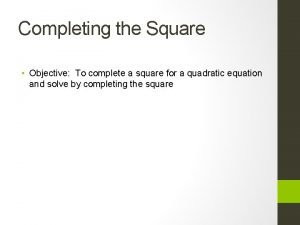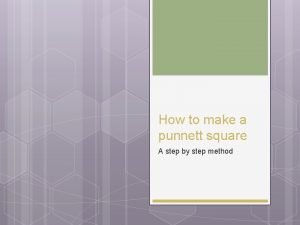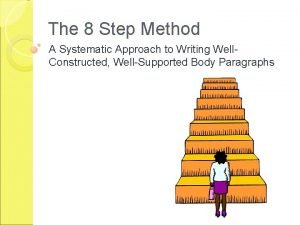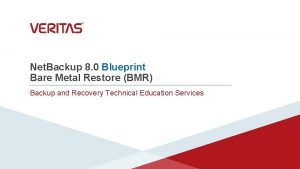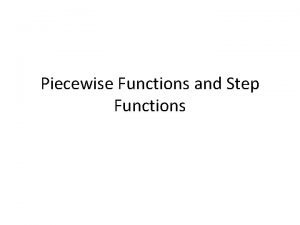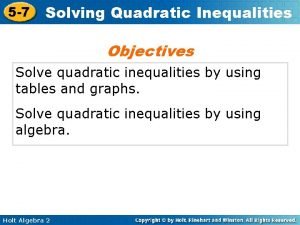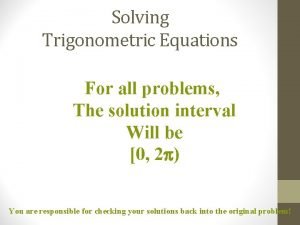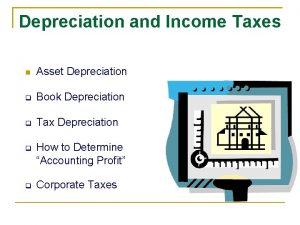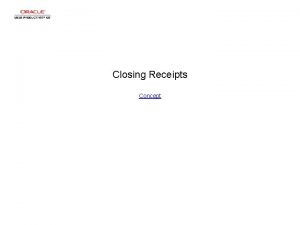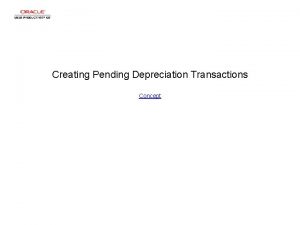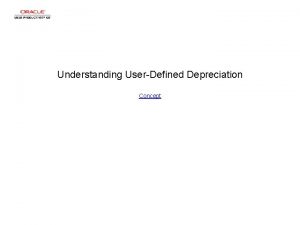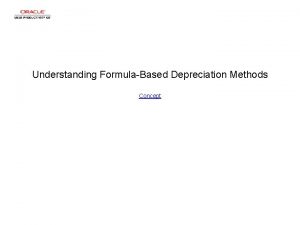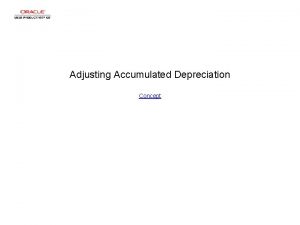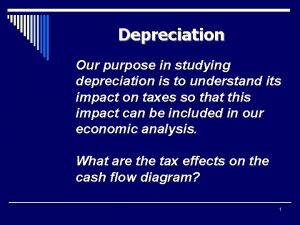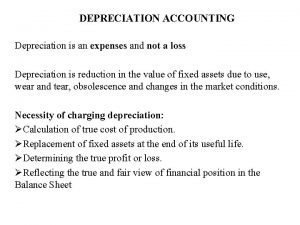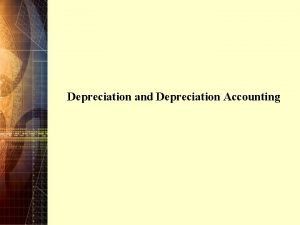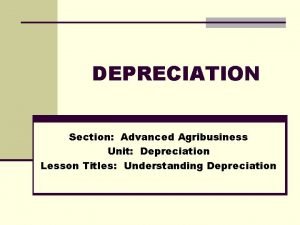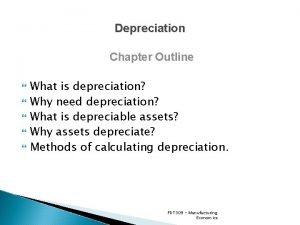Closing Depreciation Concept Closing Depreciation Closing Depreciation Step



































- Slides: 35

Closing Depreciation Concept

Closing Depreciation

Closing Depreciation Step 1 Begin by navigating to the Run Depreciation Close Process page. Click the Scroll Down arrow.

Closing Depreciation Step 2 Click the Asset Management menu.

Closing Depreciation Step 3 Click the Accounting Entries menu.

Closing Depreciation Step 4 Click the Close Depreciation menu.

Closing Depreciation Step 5 You can run this process by searching for an existing run control ID or you can add a new value. Creating a run control ID that is relevant to the process may help you remember it for future use. Click the Add a New Value tab.

Closing Depreciation Step 6 A Run Control ID is an identifier that, when paired with your user ID, uniquely identifies the process that you are running. The run control ID defines parameters that are used when a process is run. These parameters ensure that when a process runs in the background, the system does not prompt you for additional values. Enter the desired information into the Run Control ID field. Enter "CLOSE_DEPR".

Closing Depreciation Step 7 Click the Add button.

Closing Depreciation Step 8 Use the Close Depreciation page to enter the request parameters. The system will use parameters to define the processing rules and data to be included when the process is run.

Closing Depreciation Step 9 Use the Request ID field to prioritize this process. For this exercise, accept the default value.

Closing Depreciation Step 10 Click the Process Frequency list.

Closing Depreciation Step 11 Click the Once list item.

Closing Depreciation Step 12 Click in the Unit field.

Closing Depreciation Step 13 Enter the desired information into the Unit field. Enter "US 001".

Closing Depreciation Step 14 Click the Book Name list.

Closing Depreciation Step 15 The Book Name list is populated with books associated with the business unit in the Unit field. Click the CORP list item.

Closing Depreciation Step 16 Click in the Fiscal Year field.

Closing Depreciation Step 17 Use the Fiscal Year field to specify the accounting year for which the depreciation needs to be closed. Enter the desired information into the Fiscal Year field. Enter "2009".

Closing Depreciation Step 18 Click in the Period field.

Closing Depreciation Step 19 Use the Period field to specify the open periods that need to be closed. Enter the desired information into the Period field. Enter "5".

Closing Depreciation Step 20 Click the Run button.

Closing Depreciation Step 21 Use the Process Scheduler Request page to enter or update parameters, such as server name and process output format.

Closing Depreciation Step 22 You must select a server name to identify the server on which the process will run. If you use the same run control ID for subsequent processes, the server name that you last used will be the default in this field. Click the Server Name list.

Closing Depreciation Step 23 Click the PSNT list item.

Closing Depreciation Step 24 Use the Type field to select the type of output that you want to generate for this job. Your choices are Email, File, Web, and Window.

Closing Depreciation Step 25 Use the Format field to define the output format for the report. The values depend on the process type that you selected. In this example, the default value is TXT.

Closing Depreciation Step 26 Click the OK button.

Closing Depreciation Step 27 Notice that a Process Instance number appears. This number helps you identify the process that you have run when you check its status.

Closing Depreciation Step 28 Click the Process Monitor link.

Closing Depreciation Step 29 Use the Process List page to view the status of submitted process requests.

Closing Depreciation Step 30 The current status of the process is Queued. The process is finished when the status is Success.

Closing Depreciation Step 31 Continue to click the Refresh button until the status is Success. Click the Refresh button.

Closing Depreciation Step 32 The Run Status is now Success.

Closing Depreciation Step 33 You have successfully closed depreciation. End of Procedure.
 Step 1 step 2 step 3 step 4
Step 1 step 2 step 3 step 4 Completion of the square
Completion of the square Dimensional analysis step by step method
Dimensional analysis step by step method Draw a punnett square of an ss x ss cross
Draw a punnett square of an ss x ss cross Life cycle of a star video
Life cycle of a star video Combine like terms equations
Combine like terms equations Two step inequalities with fractions
Two step inequalities with fractions The age of the dinosaurs text structure
The age of the dinosaurs text structure The 8-step method
The 8-step method Write all the steps from thread to saree
Write all the steps from thread to saree Inside of a water tower
Inside of a water tower Dewey anderson classification
Dewey anderson classification Oracle zdm step by step
Oracle zdm step by step Kesler science balancing chemical equations
Kesler science balancing chemical equations Limerick examples
Limerick examples Veritas bare metal restore
Veritas bare metal restore How to divide with decimals step by step
How to divide with decimals step by step Piecewise step function
Piecewise step function How to factor equations
How to factor equations Caiet de evaluare step by step
Caiet de evaluare step by step Step 1 in 7 step improvement process
Step 1 in 7 step improvement process Quadratic inequality example
Quadratic inequality example Describe the process of preparing apple juice in 5 steps
Describe the process of preparing apple juice in 5 steps Phase one denial
Phase one denial Exponential and logarithmic inequalities
Exponential and logarithmic inequalities A perfect square trinomial
A perfect square trinomial Eyebrow waxing procedure milady
Eyebrow waxing procedure milady The steps of photosynthesis
The steps of photosynthesis How to save viva video in gallery
How to save viva video in gallery How to solve trigonometric equations step by step
How to solve trigonometric equations step by step Informative essay outline
Informative essay outline Visual studio disassembly
Visual studio disassembly Steps in dishwashing
Steps in dishwashing Wpf step by step
Wpf step by step How to make wudu
How to make wudu Step-by-step assembly instructions
Step-by-step assembly instructions

